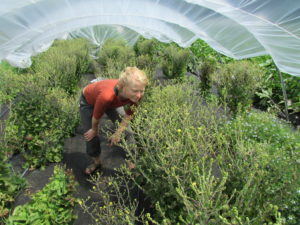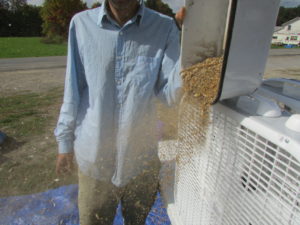Four Easy Seeds to Save This Season
Why save seed?
You’ll have seed better suited to your farm or garden than any you could buy. You’ll learn tons about plants, food and yourself in the process. Growing, saving and sharing seed is as profound as it is fun!
A century ago, to be a gardener was to be a seed saver. Selecting the best plants of each variety for seed and sharing them with our community is an essential tradition of countless generations.

Saving seed, we see each plant’s entire life cycle. Do you recognize this lettuce plant? Photos by Petra Page-Mann
We save seed for many reasons. We become better farmers as we pay greater attention to subtle shifts in plant health and local conditions. Adapting to our farms’ soils and cultivation methods, the quality of our seed is higher than any commercially available. We continue to improve and breed new varieties to be delicious, nutrient-dense and disease-resistant in our climate. It is an adventure to pay attention to your garden in a new way and exciting to share your knowledge with other gardeners, especially at community gardens and seed swaps. In terms of strict dollars and cents, it’s debateable whether you’ll save money, but consider: you may pay more than you would at the store for each quart of salsa you put up, but you can’t buy that kind of flavor and nutrition, either. Each seed you save is more adapted to your garden than any seed you’ll ever buy; that saves you more than money.
It’s easy to save seeds from crops like beans, tomatoes and lettuce once you learn the basics. Start saving seeds with the easy crops and your confidence will grow. Here are four easy crops for you to save this season!
Beans
If you grow dry beans you are already saving seed! For snap beans, simply leave some pods on the plants to mature and save those seeds to sow for next year’s crop. Be sure to save seed only from plants that are completely healthy and disease-free. Beans are self-pollinated, so separate each variety by ten feet to keep each genetically distinct.
To truly select your bean crop for the resilience of future generations, mark the sturdiest plants that flower first and show no disease throughout the season with a piece of colored string or a tag. Also, save seed only from the pods with the most beans. You’ll see a difference in your future garden even in a single season!
Once the pods are brown, dry and beans are rattling inside, they’re ready to harvest.
It’s fun to shell beans by hand with friends, and especially with children. If you’re saving a large quantity, wrap the pods in a large, clean tarp (like a burrito) and have a dance party on them. Again, kids are crucial! When most of the pods have shattered, separate the beans from the dried plant debris (called chaff) using a box fan on a table. The air blows the chaff away while the seed falls straight down in to a bucket on the floor below the fan. For a video demonstration of cleaning seed with box fans, check out Fruition Seeds on YouTube.
Lettuce
Lettuce seed is one of our favorites to save! Beautiful and often so effortlessly abundant, space lettuce for seed as you would for full-size heads rather than for salad mix. What you don’t save for seed goes on your plate so be sure to plant plenty of both! Select plants for seed that are vigorous, true to type, disease-free and late-bolting. The first handful to bolt get composted! Lettuce is also self-pollinated, so maintain at least ten feet between lettuces for seed to keep each variety genetically distinct.
Lettuce going to seed will often be as tall as you! Each tiny yellow flower will become a dandelion-like tuft of seed and fluff when ready to harvest. You can pluck each tuft by hand or shake the seed stalk into a bucket to free the seed. Cleaning lettuce seed is very challenging, since the seed and the chaff are both very small and light, but screens and colanders work wonders. Most important, be sure sure you harvest your lettuce on a hot, dry day and be sure it is dry as can be when you store it for next season.
Tuck the dessicant packs you find in shoes and seaweed in with your seeds to keep them as dry as possible!
Tomato
With beans and lettuce, we have to restrain ourselves and not eat the plants that we save for seed. With tomatoes, however, we have our cake and eat it, too! When the tomato is ripe and ready to eat, its seeds are mature: we have the best of both worlds. Also self-pollinated, twenty feet is often enough to keep separate varieties genetically distinct. Save seed only from plants that are vigorous, true-to-type, early maturing and free of disease.
To save tomato seeds, simply squeeze the seeds out of the tomato and into a jar. You’ll notice each seed is surrounded by a thin gel; this coating contains natural compounds that inhibit seed germination to prevent them from sprouting in the warm, moist tomato. In nature, this coating is broken down as the tomato decomposes. In our kitchen, we ferment the coating using a simple process. Add water about equal to your squeezed seed, label with the variety name, cover with a cloth and leave in a warm place for a few days. If you ferment your seed in a glass jar, you’ll be able to see the layers that separate: heavy, mature seed on the bottom, a layer of cloudy water and a layer of pulp and light, immature seed on top. Gently pour off the molded top layer and rinse the seeds well, spreading them out on (labelled!) screens or paper towels to dry.
Cilantro
Annual herbs such as cilantro, dill and basil have seeds easily saved. Plant them as early as you can and with plenty of space, four to eight inches apart at least. Keep plants well watered to encourage them to grow large and robust before going to seed.
Especially with cilantro, remove the first plants that send up their seed stalk to ensure you’re selecting for late bolting! Save seed only of completely healthy plants as soon as their seed is dark and dry to reduce the risk of the seed getting wet, diseased or prematurely dispersed. Screens, colanders and fans do a remarkable job of cleaning the seed that you’ll likely have tons of for years to come.
Let the adventure begin!



Global One Urban Farming is a non-profit 501 c 3 organization growing. My name is Staroyce Nealy, one of the founders. Just wanted to say Thank you for the saving seeds lesson. Hope to learn a lot more.
What the issue of mold mildew and invasives…
Some of our common plants become an issue of seed saving & local exchanges from these plants.
Get in the know before you trade and so.
If you share be aware!